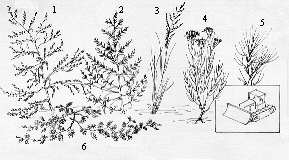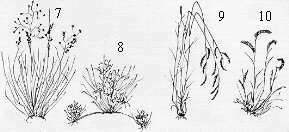 |
The West Mesa, shaped primarily by water, wind, and volcanic activity, lies west of the Rio Grande inner valley within the Rio Grande Rift. At one time, this area was actually part of the Rio Grande floodplain. The river meandered over a broad section, depositing silt and gravel, and cut terraces, some of which can still be seen on the Mesa. Much of the sur- face layer consists of fine, wind-blown sand which is reworked periodically.
Clearing or overgrazing the soil frequently resulted in a hard pan, or cliche layer, formed and exposed by wind erosion. Thick sod grasses which formerly held down the soil were often replaced by disturbance-associated grasses frequently found around the school yard (fluff grass, sand drop seed, and threeawn), as well as by such wildflowers as locoweed, snake weed, purple aster, and the poisonous purple nightshade. Introduced species such as tumbleweed are now the dominant plants in many areas of soil disturbance. With less than 10 inches (25 cm.) average annual precipitation, Mesa plants and animals must be adapted to dry environments. Plant adaptations include small leaves, spines, and hairs surrounding breathing pores.
  |
DISTURBANCE-ASSOCIATED, INVADING VEGETATION
|
Nocturnal animals (kangaroo rats, pocket mice, white footed mice, and wood rats), most of whom burrow in the ground to escape the heat and drying, are very common. Lizards, horned lizards, several varieties of harmless snakes, and even the spade foot toad are also frequently found on the West Mesa. The birds to be looked for around the school yard are English sparrows, starlings, and pigeons.
There is evidence that the Mesa is changing from a short grass prairie to a desert grassland. Scattered remnants of pinions, juniper, and yucca are indicative of a wetter time. Overgrazing has undoubtedly hastened this change, and a lowered water table may also have had an effect.
(Up to Section IV, Back to Abiotic/Biotic Profiles, On to A Valley School)